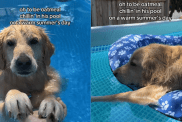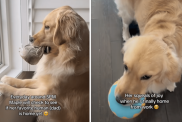Learning “How to turn the little critter OFF” is one of the most important tricks of the trade. Living with a dog on Duracell starts to wear thin once you realizes your dog’s speed and endurance are increasing with age. It becomes bearable only if your puppydog will settle down and be quiet for at least some of the time and especially at times of your choosing.
Establish the status quo right from the outset. Several times a day, put your pup on leash and have it settle down and be quiet for five minutes, half an hour or whatever. “Settle Down” means remain quietly in this spot, lying down comfortably. You may give your dog the option of stretching out, curling up, lying on its side or back or adopting the formal ‘sphinx’ down position. Your pup must be taught early that we have to have ‘little quiet moments’. To remember to do this on a regular basis, it is a good idea to coordinate the exercise with owner-activities. For example, each family member should have the pup settle down next to them several times a day – each time he/she reads the newspaper, works on the computer, watches television, makes dinner eats dinner, or goes to bed. To make things easier, you may leash the dog or put it on a tie-down. Your pup may be restless and vocal at first, but within only a few days, it will soon get the picture.
Initially, have your puppy settle down right next to you, but later on, practice with your pup at a distance or in a different room. A useful trick is to incorporate the settle down request with a “Go to…” command and to tell the puppy to go to its mat (dog-bed, basket, kennel, crate, or tie-down etc.) and settle down. Tell your pup to go to its mat for example, and then lead it to the mat with a food treat, which the pup receives once it is lying down. Very young puppies learn place commands quickly and easily, and if the pup’s basket, for example, is always kept in the same position, your puppy will learn the “Go to your basket” request in no time at all. While the pup remains put, periodically praise, pet or offer occasional food treats. If your pup tries to move, simply repeat the “Go to your mat” and “Settle down” requests, and this time, stay closer to the pup to control it.
Mats and crates are especially useful, since they are easily portable and can be a boon when traveling with the dog and staying at motels, the summer cabin or Granny’s house. It is easy to throw down the dog’s mat or set up its crate, and instruct the dog to settle down while unloading the car.
The settle down command renders even the most rambunctious and rumbustious little (or big) critter manageable at home. However, dogs are fine discriminators; they learn exactly what you teach them. If they have been taught to settle down at home, they will still act like maniacs at the park or in the vet’s waiting room. Consequently, practice this exercise away from home.
When your puppy is old enough (completed its series of puppy shots) to go outdoors, train it to settle down on walks. Take along a newspaper or a gripping novel. At the corner of each block, tell the pup to settle down, and read a couple of pages before proceeding. Interspersing little quiet moments in an exciting walk is one of the best ways of teaching your puppy to settle down, no matter what the distraction. Moreover, each little quiet moment is reinforced by resuming the walk, i.e., you may now use the walk as a reward for good behavior many times over. (Otherwise, owners tend to use the walk as a reward only once, for unintentionally reinforcing the dog’s banana-like behavior when it sees its owner put on hat and coat or reach for the leash in preparation for a walk.) Similarly, during play sessions at home or in the park, periodically instruct your dog to settle down for a short time-out before resuming play.
The goal is not to spoil the puppy’s fun by forcing it to settle down for hours on end but to frequently practice calming your dog when it is excited, so that you learn how to ‘turn your dog off,’ if and when necessary. If you can convince a distracted and playful puppy to settle down for just 30 seconds, you could easily keep the pup down for several minutes. The hard part is getting the pup to settle initially, not keeping it settled. Consequently, repeatedly ask your pup to settle down for many short periods within a single walk or play session. Integrating training is the secret to eager reliability.
Excerpted from How to Teach a New Dog Old Tricks, by Ian Dunbar.
Ian Dunbar is a veterinarian and animal behaviorist, founder of the Association of Pet Dog Trainers, and the author and star of numerous books and videos on dog behavior and training. He lives in Berkeley, California with his wife, trainer Kelly Dunbar, and their three dogs. The Dunbars are contributing editors to DogTime.









